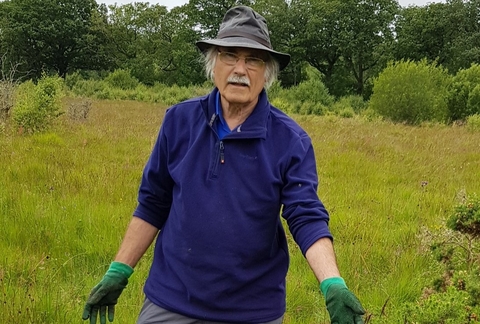
Steve Doyle
'My next question was ‘who is doing anything about it?’ The answer I got from everyone was ‘nothing!’ To me that was simply not good enough and I vowed to take action.'
Steve Doyle
Steve was nominated by members of our Planting for Pollinators team. He has been instrumental in bringing several species of butterfly back from the brink, ensuring their continued existence in Cumbria, and passes his expertise and experience on to others so they can continue this work.
'I first became interested in wildlife, butterflies in particular, back in the 1970s. I was born in Carlisle and went to school there but as a ‘city’ boy didn’t know much about wildlife. When I left school, I pursued a career away from Carlisle which culminated in me working out of a London base and barely seeing my home in daylight until the weekend – so my leisure time became precious to me and that’s how my interest was gained.
In the countryside, I could see butterflies I’d never seen before, so I bought a butterfly book in a shop in Cannon Street, London. I was amazed there were 59 different butterfly species in the UK and vowed to see and photograph them all, which I did within a couple of years, except for Marsh Fritillary which escaped me. I followed up several sighting locations but found nothing.
When I reached 50, I was given an option of redundancy and I decided to move back to Cumbria with my family. I looked at my butterfly book and saw Marsh Fritillary could be seen there, so I could easily fill the gap in my photo collection – OR SO I THOUGHT!
I read in journals that there were 100 or more colonies in Cumbria, so I contacted the County Recorder to locate some. He said the Marsh Fritillary was by now almost if not already extinct in Cumbria. He gave me a few sites to explore and I did find one site near Keswick and then another near Penrith, both of which were ‘on their last legs’ it seemed to me.
My next question was ‘who is doing anything about it?’ The answer I got from everyone was ‘nothing!’ I vowed to take action. Butterfly Conservation didn’t even have a branch in Cumbria, so I set one up straight away, became their first Chairman and soon after set up a Cumbrian Marsh Fritillary Action Group. To do nothing was simply not good enough.
The Marsh Frit was declared extinct in Cumbria in 2004, despite last ditch efforts to save it, because it had already passed the point of no return. However, I did find a single larval web containing 68 caterpillars. We took the remaining Cumbrian caterpillars into captivity (under licence from Natural England) and ‘borrowed’ a similar number of caterpillars (also under licence) from the western isles of Scotland to cross breed them with our remaining Cumbrian ones, to at least conserve some Cumbrian genes.
What about the habitat? It was decided we would use the last four sites which had become extinct and use those as ‘core’ release sites around which we would find and manage other suitable habitat which could be colonised as satellite sites within a 5 kilometre radius to allow for longer term self-colonisation.
SUCCESS - in Summer 2007 the Cumbrian countryside was adorned with lots of Marsh Fritillary butterflies across our four release sites. It was a wonderful sight and brought goosebumps to my body as I stood out on site with Marsh Fritillary butterflies flying all around me, as if they were deliberately saying ‘thanks.’
By 2017, we found 3252 larval webs. Success has continued in 2018, 2019 and 2020 so that we now have over 30 colonies in the wild having released around 120,000 larvae and our strategy of ‘mass’ releases had paid off with most of the colonies now there by self-colonisation by the butterflies themselves. They are better at finding habitat than we are, we just gave them a helping hand.
What we have done in Cumbria is something which has never been done before anywhere, a successful reintroduction of Marsh Fritillary butterflies. They said ‘It can’t be done, don’t waste your time.’ We proved that it can be done if it’s done thoroughly and properly, and that’s what we did.'
